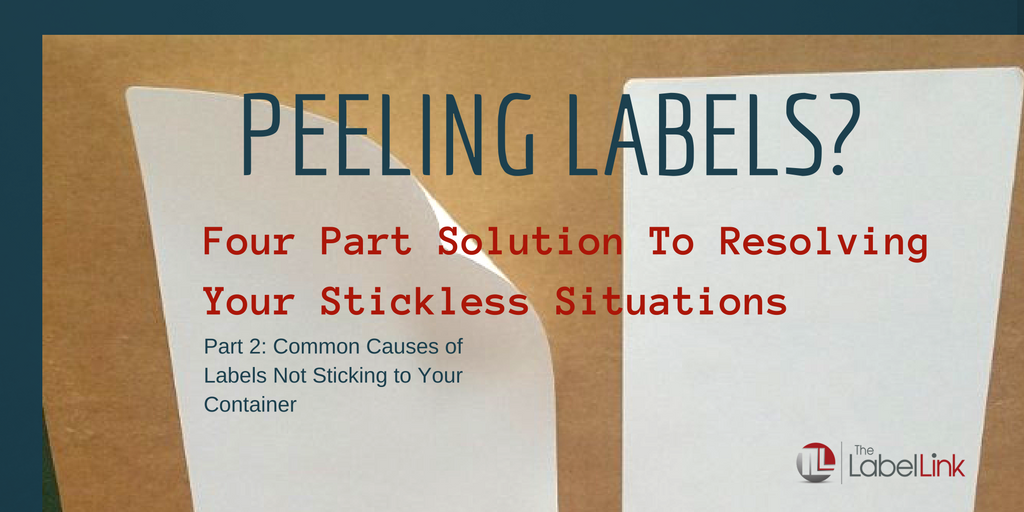
The Dreaded Label Lift Part 2: Causes of Labels Not Sticking on Containers
When you choose a label or adhesive for your substrate (or container), chances are it comes with guidelines for how permanent or removable it is. But did you know, these are just guidelines? There is no way of knowing whether or not a label will act the way it’s promised when it’s applied to your containers.
Label lift is a big problem for manufacturers. It can mar your brand and prevent sales unintentionally. There are four main issues (or what manufacturers think of as common issues) when it comes to labels lifting off of products:
- Bad adhesive
- Substrate surface
- Tight mandrel (or diameter curve)
- Environmental conditions
We’ll be addressing each of these issues in separate posts. Last week, we talked about bad adhesive (and why it’s not usually the culprit for label lift). This week, we’re talking substrate surfaces. Let’s dig in.
There are Many Reasons Your Labels Might Not Stick to Your Containers As Planned
It’s frustrating. We get it. But sometimes, the recommendations made by some label companies for your containers simply aren’t accurate. Often times, missing application information is the real culprit. Here are a few reasons for labels not sticking.
1. Texture
The texture of your container plays a major role in how well a label will adhere. Here’s an example to show what we mean:
If you had a standard removable adhesive and placed it on newspaper, you would probably have a hard time getting it off cleanly without tearing the paper. However, if you put the same label on a non-stick pan, your chances of quickly removing the label cleanly without residue are far greater. In fact, it may not adhere strongly enough creating a different problem.
This is an obvious example but it illustrates the point. The application is critical.
Most of the time the application won’t be as clear cut as applying your label to a newspaper or a non-stick pan. Instead, the texture of your container will vary ever-so-slightly. For example, many glass bottles and jars have anti-scratch agents on them that perform similarly to non-stick pans.
Talk to your label printer about the specifics of your container and ideally, supply samples so that the correct adhesive can be recommended for testing.
2. Vinyl (or Plasticizer)
Vinyl is not eco-friendly, which has caused it to see a steep decline in how much it’s used now. Still, for many years, it was the plastic material of choice because it was so pliable. Today, there are still a few bottles that are made out of vinyl. You’ll be able to tell by its smell (think of the vinyl shower curtain smell) or by the marking for recycling #3 with a V under it.
If your container is made out of vinyl, it has plasticizer. Plasticizer is what makes it soft and flexible. When it comes to the adhesives you’re using, many of these are also made of rubber-based, plastic resins, which means when applied, the plasticizer will react accordingly. Labels on vinyl will degrade to the point that eventually they fall off. You don’t want a six-month shocker when your labels fall off at the retailer.
Rubber-based, soft adhesives will get broken down over time by the plasticizer. In the end, the label won’t stick as easily and may even fall off. It can leave behind a plastic residue too, which is what’s commonly seen on vinyl binders.
The solution: Know what type of plastic you’re using. Then, match your adhesive with the right kind of plastic so you get the best stick.
As a side: If you are using vinyl containers, it might be worthwhile to consider using a more eco-friendly container. Not only will you help preserve the environment but the standard adhesives could also save you money.
3. Spillage
Personal care, and food and beverage products have one thing in common: They both have the propensity to spill onto the container during a production fill. If the product is oil-based (as many health, beauty, and food products are), it can be a recipe for disaster when it comes to label lift.
Even if the consumer wipes down the bottle regularly, the oil will still cover the surface of the adhesive, interfering with its ability to properly stick to your container.
If this is the case with your product, you must test your container surface before applying them. To do this, rub your container with rubbing alcohol to clean it. Then, apply a new label from the same lot. If it sticks, you know you must take extra steps to clean your containers. To do this, you must:
- Apply the labels prior to filling the bottle with your product, and ensure the material used is moisture or oil resistant.
- Wipe down your containers with alcohol or go through a cleanser bath before applying the label.
- If that’s not an option, use a wrap label so the overlap sticks to itself rather than your container.
- If there’s an opportunity to lessen the spillage, use that.
Question: What’s been the biggest challenge with label lift?
It’s not always easy to nail down the cause of label lift. That’s why we’re doing a four-part series on it. There are so many reasons why it could be stopping your labels from sticking to your bottles.
